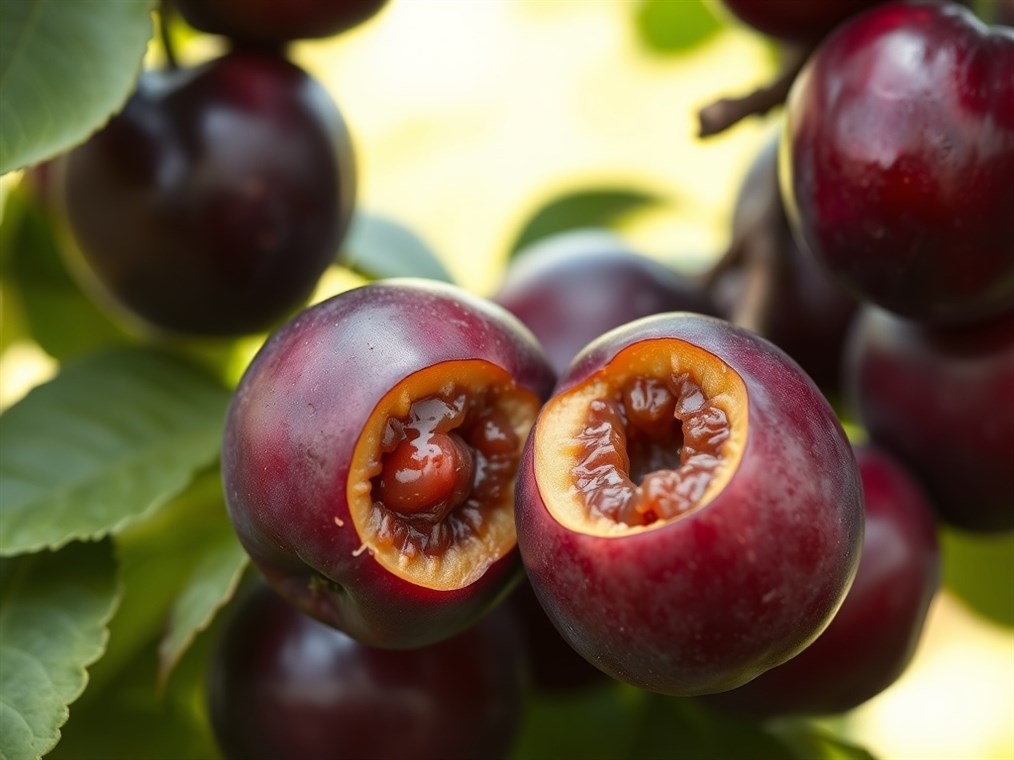Why Are My Plums Splitting? Let’s Get to the Bottom of This!
There’s nothing quite like the anticipation of biting into a perfectly ripe, juicy plum straight from your own tree. But then… disaster strikes. You head out to harvest, only to find your beautiful plums have split right open! It’s a heartbreaker, I know. This isn’t some weird disease, but a common problem that leaves your fruit vulnerable to pests and rot. So, what gives? Let’s dig in.
The number one reason plums split? Think of it as a hydration issue – specifically, inconsistent watering. Imagine your plum tree is wandering through a desert for weeks. The plum skin gets all tough and leathery. Then, BAM! A sudden downpour, or maybe you just decide to give it a good, long soak. The fruit goes into overdrive, soaking up all that water like a sponge. But the skin? It can’t stretch fast enough, and crack! Splitting occurs. It’s like trying to blow up a balloon too quickly. This is especially true when the plums are in their final growth spurt, right before they’re ready to pick.
Now, some plums are just drama queens when it comes to splitting. Japanese plums, for instance, tend to be more prone to cracking than their European cousins. Even within those groups, you’ll find some that are tougher than others. I’ve heard good things about Stanley plums being more resistant. So, if you’re planting a new tree, choosing a less sensitive variety is a smart move. Think of it as picking the right breed of dog – some are just naturally more chill!
But it’s not just about water. What your tree eats matters too. Think of calcium and boron as the building blocks for strong, flexible plum skin. They help those cell walls stay strong. On the flip side, too much nitrogen can make the skin thin and weak, like tissue paper. And copper? That’s another cell wall thickener.
Of course, there are other things that can contribute to the problem:
- Too much rain: I mean, who doesn’t love a good rain shower? But if it’s been raining cats and dogs for days, the plums can actually absorb water right through their skin.
- A small harvest: Believe it or not, if your tree isn’t producing many plums, the ones that are there might be more likely to split.
- Hot weather: Blistering heat can mess with the cell walls, making it easier for water to rush in.
- Overdoing the fertilizer: Too much of a good thing, like potassium and nitrogen, can push the tree to grow too fast, stressing out the fruit.
- Pit issues: Ever heard of “pit split”? It’s when the pit inside the plum cracks. While not directly causing the skin to split, it can make the fruit wonky and more susceptible to problems.
Okay, so what can you do about it? Here’s the battle plan:
- Water consistently: This is key! Keep the soil evenly moist, especially when the plums are getting close to being ripe. Deep watering during dry spells, followed by a good layer of mulch, is your best bet.
- Mulch it up: Mulch is like a cozy blanket for your tree’s roots. It helps hold in moisture and keeps the soil temperature steady. Wood chips are a great choice.
- Feed it right: Make sure your soil has the right balance of nutrients. A soil test can tell you if you’re missing anything. You might also try spraying the leaves with calcium and boron. Just don’t go overboard with the nitrogen!
- Pick the right plum: As I mentioned before, some varieties are just tougher than others.
- Prune it properly: Pruning helps air circulate and reduces the load on the tree.
- Harvest on time: Don’t let those plums sit on the tree and get overripe. Pick ’em when they’re ready!
- Fungicides: If you see cracks, a fungicide can help prevent nasty stuff from getting in.
- Get some cover: If you’re serious about your plums, you might consider using rain covers or even a high tunnel to keep the fruit dry. Some growers even use helicopters or giant blowers to dry off their fruit! Talk about dedication.
- Copper is your friend: Applying copper sprays a few weeks after the blossoms fall can help thicken up that skin.
Now, the big question: can you eat split plums? Generally, yes, as long as they don’t look or smell rotten. If the cracks are just little lines, you’re probably fine. But if they’re big, gaping wounds, I’d be a little more cautious. And definitely toss anything that smells funky.
So, there you have it. Plum splitting can be frustrating, but with a little understanding and some preventative measures, you can keep your plums happy, healthy, and crack-free. Happy harvesting!

